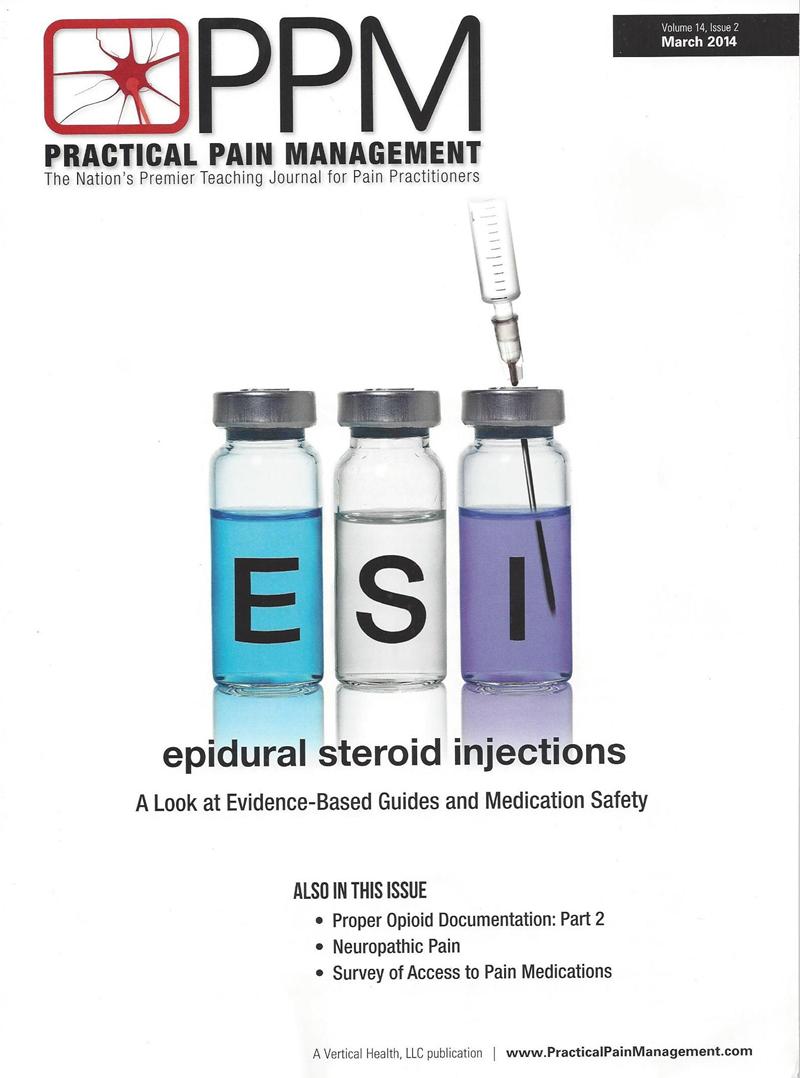Access to Pain Medication Survey Results Printed in Practical Pain Management Journal
 The NFMCPA often requests participation in research surveys and we are dedicated to reporting the results of those surveys back to our constituents. In June, 2013 we developed and posted the Access to Pain Medication Survey on Survey Monkey. A total of 5,159 respondents with either fibromyalgia or other types of chronic pain logged on to the website link and consented to take part in the survey. Ages ranged from 19 to 85, with the youngest and oldest in the cohort most likely to report having been denied a prescription. The level of education reported was most often a college (22.1%) or high school (19.1%) degree, followed by those who had two (17.2%) or one (13.2%) year(s) of college experience. 609 (12.4%) reported obtaining a graduate degree. The most often cited pain complaints (not mutually exclusive) were fibromyalgia (91.9%), low back (64.8%) and neck (49.2%) pain, followed by migraines (42.2%) and neuropathic pain (42.2%).
The NFMCPA often requests participation in research surveys and we are dedicated to reporting the results of those surveys back to our constituents. In June, 2013 we developed and posted the Access to Pain Medication Survey on Survey Monkey. A total of 5,159 respondents with either fibromyalgia or other types of chronic pain logged on to the website link and consented to take part in the survey. Ages ranged from 19 to 85, with the youngest and oldest in the cohort most likely to report having been denied a prescription. The level of education reported was most often a college (22.1%) or high school (19.1%) degree, followed by those who had two (17.2%) or one (13.2%) year(s) of college experience. 609 (12.4%) reported obtaining a graduate degree. The most often cited pain complaints (not mutually exclusive) were fibromyalgia (91.9%), low back (64.8%) and neck (49.2%) pain, followed by migraines (42.2%) and neuropathic pain (42.2%).A total of 3,879 (75.2%) reported that they were currently taking a prescription pain medication. The most often reported medications were hydrocodone (39.4%), oxycodone (26.6%), morphine (7%), and fentanyl (6.7%). Of the 3,879 patients 1,289 (69.2) reported being on the medications for over a year and 460 respondents reported they had been on the medication for at least a few months (24.7). Overall, 846 (18%) stated that they had been denied having a prescription filled by a pharmacist on at least one occasion, with 63.6% reporting that they had obtained opioid prescriptions at the same pharmacy on more than 10 different occasions previously and 18% reporting that they had successfully filled opioid prescriptions at the same pharmacy from 3 to 10 times previously. Only 8.5% of the respondents who reported being denied the filling of their prescriptions had never previously used the pharmacy that denied the prescription.
Respondents with a history of being denied a prescription were asked to relate what reasons the pharmacy gave them for filing to fill the opioid prescription. The most frequent reason cited was that the pharmacy did not have enough medication in stock (52.9%). Other reasons for denial included having the pharmacists feel the dosage was inappropriate (23.3%), the pharmacy was no longer stocking the drug (21.8%), or that there was a national shortage of the opioid (20.7%). For those denied, the vast majority (86.3%) stated that the pharmacist did not help them find an alternate pharmacy that might be able to fill the prescription.
After experiencing a denial, a majority (n=506, 67.3%) managed to fill their prescription somewhere else within 1 week, but 123 patients (16.4%) were never able to get the prescription filled. Of those getting the prescription filled elsewhere, most reported that they either visited 1 pharmacy (50.9%) or 2 to 4 more pharmacies (36.3%) to have the prescription successfully filled. This led to the majority of respondents who experienced a denial being out of their medications for 1 to 2 days (34.5%) or 3 to 6 days (29.3%).
The final portion of the survey concerned the global impact on those who had experienced the denial of having a prescription filled. Physical manifestation resulting from not having their medications included signs of acute withdrawal such as muscle tension (66.3%), sweating (56.1%) and nausea, vomiting and diarrhea (46.3%). Regarding the emotional impact of being out of their medications, most patients reported anxiety (76.5%), irritability (70.8%), restlessness (59.5%), or insomnia (57.4%). A specific item on suicidality found that 287 (37.7%) had considered suicide after being denied access to their medications. The cited reasons for this were increased pain (100%) and opioid withdrawal (35.5%)
The results of this important survey support the problem of people in pain being caught in the war on drugs and suffering the consequences of FDA and DEA regulations meant to deter criminals and drug seeker. The NFMCPA champions the rights of chronic pain patients to access adequate pain relief without stigma or accusation.
To read the entire article and to learn more about survey outcomes click here:




